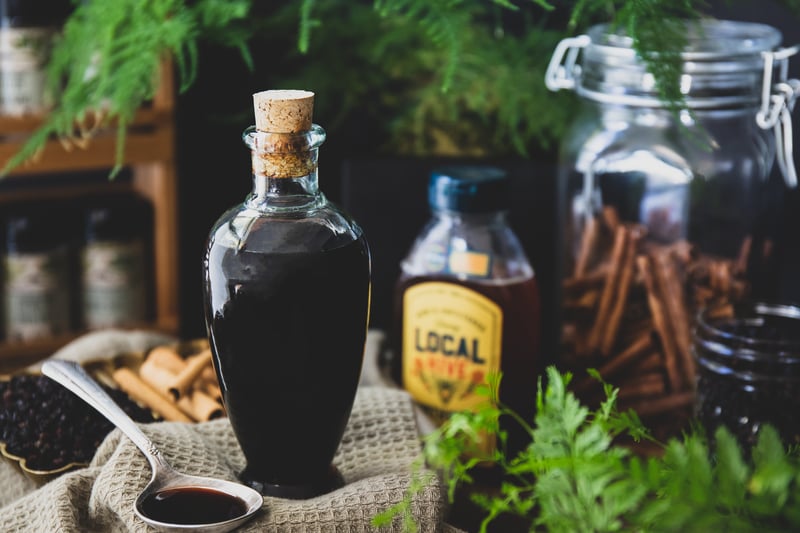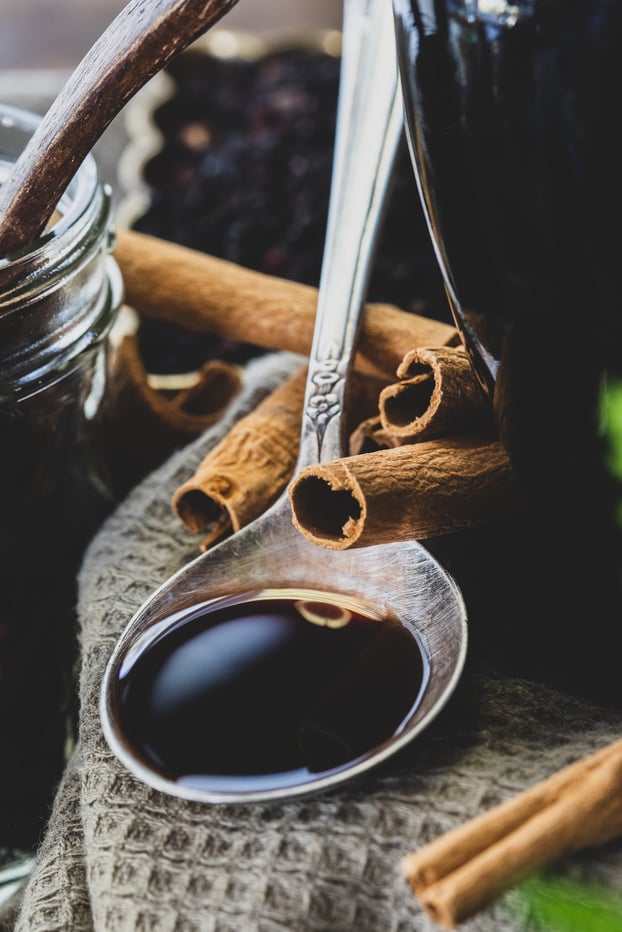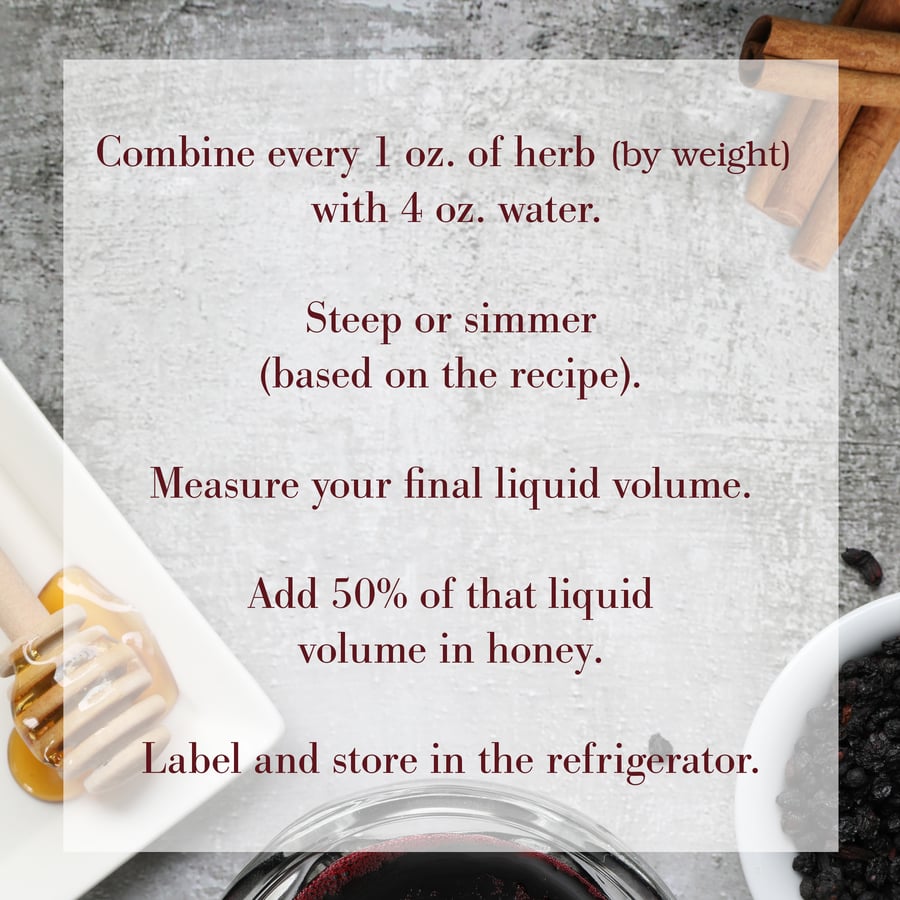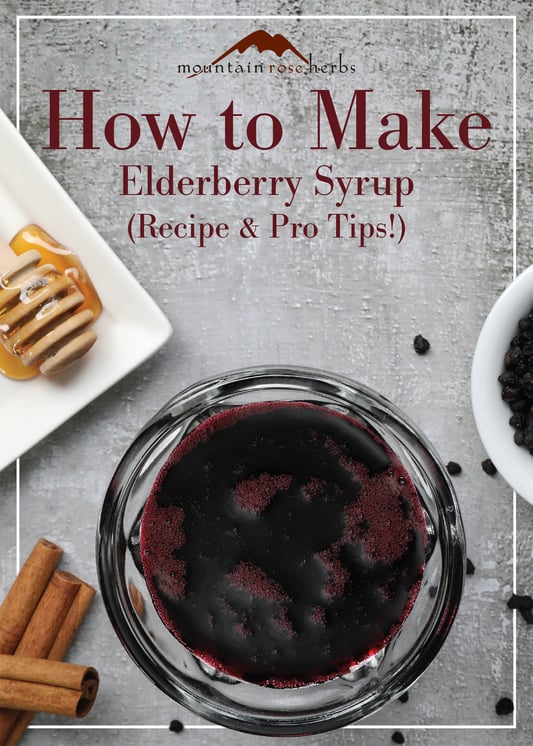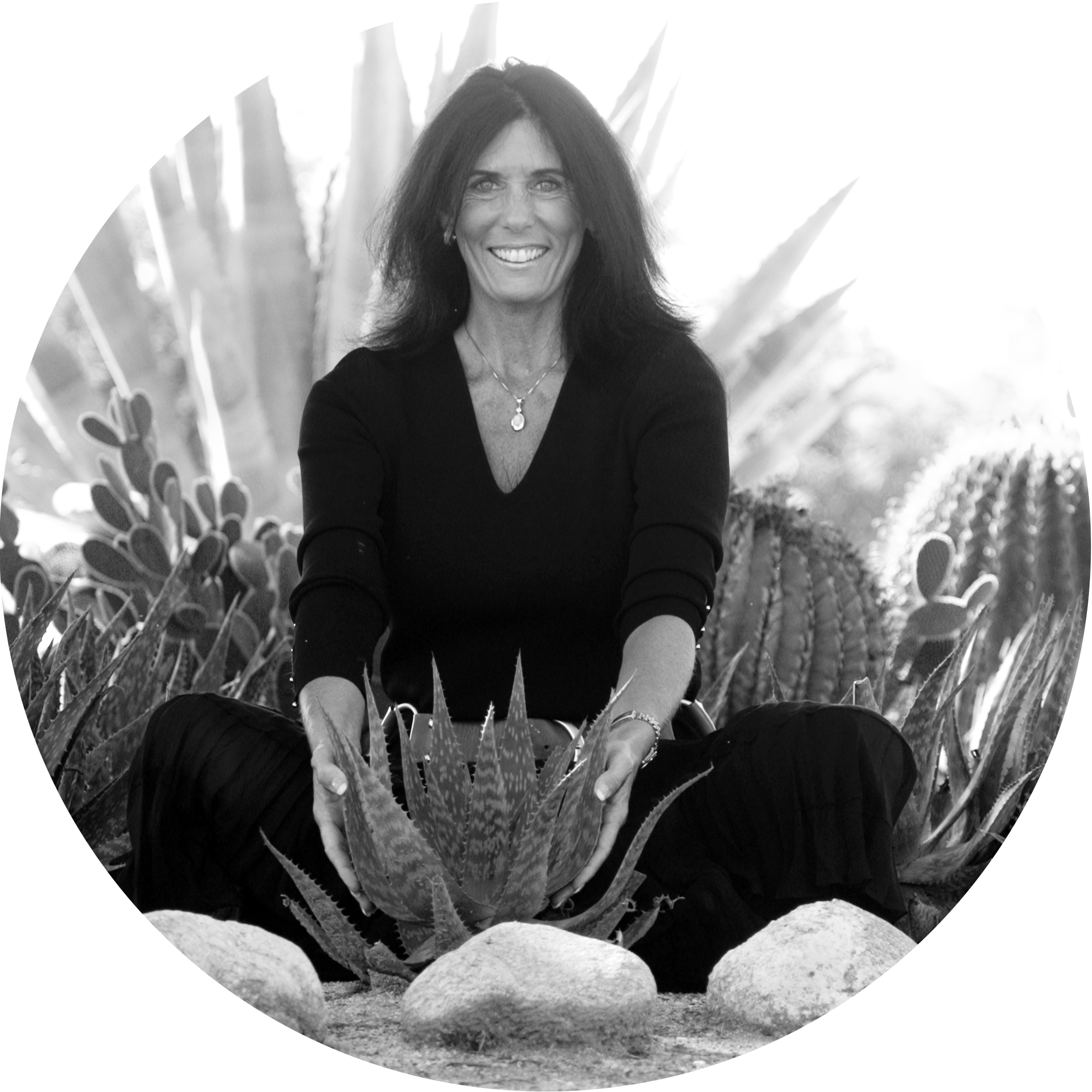Each year as winter approaches, I reliably find my patients asking me about the best herbal remedies to use during the cold weather months. One of the most common questions I encounter is, “What nutritional preparations can I use to help keep my family strong and healthy throughout the sniffle season?”. There's a wide array of herbs well-suited to addressing specific and general winter wellness goals, but one of my favorite, tried-and-true choices for general immune support is the elderberry.

And while there are lots of ways to enjoy the healthful benefits of elderberries, one of the most loved is that longtime herbal apothecary staple, elderberry syrup.
Elderberry Syrup Benefits
The berries, flowers, and bark of the elder (Sambucus) plant have long been prized by herbalists across the globe, and modern studies have also substantiated the berries’ ability to help maintain normal, healthy functioning of our immune system*. This makes elderberry an excellent plant ally to promote resilience during times when our body's systems are particularly stressed (the winter holidays come to mind!).
So why syrup? There are a couple reasons that these berries, which can be prepared in many ways, are so often enjoyed in syrup form. One reason is practicality. Most traditional elderberry syrups are made with a good portion of raw honey, and the sugar content (combined with honey’s legendary shelf life) acts as a natural preservative for your beneficial berries.
The other reason many folks choose elderberry syrup? The taste! The flavor of elderberries really shines with a little sweetening, which is why variations of elderberry syrup are used for purely enjoyable reasons, such as a topping for pancakes, oatmeal, or desserts.
Also, many traditional wellness-centric syrup recipes include some high-proof alcohol to further extend their shelf life. This added preservative can potentially allow you to enjoy your syrup all season long, but many people also appreciate how the honey or other sweetener helps mask the liquor’s flavor.
Classic Elderberry Syrup Recipe
Makes about 3 cups of syrup without alcohol, 4 cups with alcohol.
Active Time: 1 hour
Ingredients
- 2 cups dried organic elderberries
- 4 cups cold water (distilled, purified, or spring water works best)
- 2-3 tsp. organic dried ginger root or 1-2 tsp. organic dried ginger powder
- 1 organic sweet cinnamon stick
- 1 cup raw, local honey (or organic maple syrup or agave for a vegan/infant-friendly recipe); double the amount of sweetener to increase shelf life
- 1 cup vodka or brandy (optional to increase shelf life)
Directions
- Combine berries and herbs with cold water in pot and bring to a boil.
- Reduce heat and allow herbs to simmer 30 to 40 minutes.
- Remove from heat and let steep 1 hour.
- Strain berries and herbs using a funnel overlaid with doubled cheesecloth or undyed cotton muslin bag and squeeze out liquid (careful, liquid will likely still be hot!). Discard used herbs in compost.
- Once liquid has cooled to just above room temperature, add honey and stir to incorporate.
- If using vodka or brandy, add here and stir until well combined.
- Bottle in sterilized glass and store in the refrigerator.
Pro tips:
- Be sure to add honey in a ratio that is at least half of the total volume of liquid after it has simmered. This amount can change slightly and you want to make sure you have enough preservative (honey) so that your syrup won't spoil. (Example: If you are left with 2 cups of elderberry decoction, you will want to add at least 1 cup of honey.)
- This recipe is easy to multiply if you’d like to make a big batch to store or give as gifts (glass pantry jars and amber bottles are great choices!). My family enjoys a teaspoon or two of this syrup, right out of the fridge, just about every day during the sniffle season.
Tips for Making Elderberry Syrup
Should you use fresh or dried elderberries?
You can use fresh or dried elderberries for making syrup. I often use dried because they are usually easier to find and store year-round. If using fresh berries, use twice the amount of dried berries your recipe recommends.
How Can you make elderberry syrup shelf stable?
As we covered above, syrups that are shelf stable, meaning that they are able to sit out at room temperature for a long period of time without spoiling, require more sugar, alcohol, or a combination of the two. You're going to have to add something to discourage the development of bacteria and mold. To make this syrup more family-friendly, my recipe uses less sugar and no alcohol and is intended to be kept in the refrigerator. However, if you want a more shelf-stable syrup, you can double the honey in our recipe or add the optional alcohol.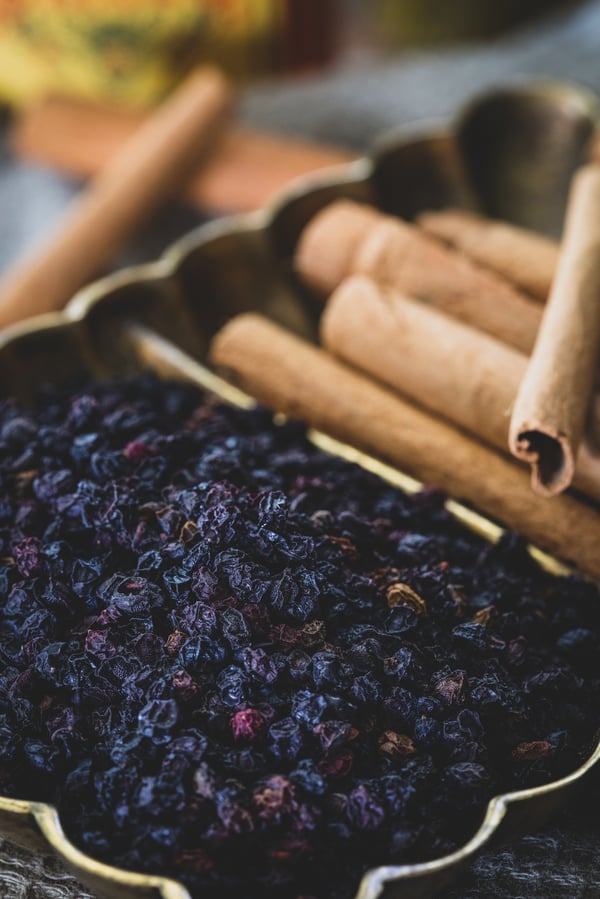
What should I cook my elderberry syrup in?
When preparing your syrup, be sure to use a ceramic, glass, or other non-reactive pan that won’t off-gas. Pans with synthetic nonstick coatings release some nasty stuff when heated, so avoid them when making syrup. I’d discourage you from having them in your house to cook anything, anyway!
What kind of water should I use to make elderberry syrup?
Remember that your finished herbal product is only as good as the ingredients you start with, and that includes water. The water you include should be distilled, or it should be a good spring water or purified water, depending upon where you live and what you have access to.
Can I add other herbs to my elderberry syrup?
I think one of the things that beginners often struggle with when they're just learning how to make herbal products for their home is being too rigid in how they do things. There’s not just one way to make spaghetti sauce—every chef has their own recipe, each with its own little tweaks of this or that—and the same principle applies here. So be creative with your syrups! You can add vanilla (I love a slice of vanilla bean in mine), cardamom tastes really good . . . just give yourself permission to play with the flavor. All those improvisations add extra goodness anyway!
Water-to-Herb Ratio for Making Syrup
How much herb-to-water to use when you're making a syrup varies on a number of factors, and two big ones are the type of herb that you're using and your overall goal. When creating a syrup to use for therapeutic purposes, I only want to have to take a teaspoon or so a day to enjoy the effects, and so I like to use a 1 to 4 ratio to create a very strong decoction that concentrates the herbal properties.
Now, when I say a 1 to 4 ratio, I'm talking about using one ounce of herb for every four ounces of water by weight.
This can be a point of confusion, but actually makes sense when you think about it, and it's important to take into account in your recipe making. One fluid ounce of water also weighs one ounce, so you can simply measure out your water by volume (in the video here, we use four cups, or 32 ounces, of water). However, one ounce by volume of one herb may have a very different weight than the same volume of another herb, depending on the density of your plant material. In the video, we use about two cups of dried elderberries to four cups of water. The volume ratio here is 2 to 4 (or 1 to 2), but each ounce of our dried elderberries by volume weighs about 1/2 ounce, so the ratio of this syrup by weight is actually 1 to 4. And a syrup made with a fluffy, lightweight plant material, such as mullein? Well, that same weight of herb is going to take up A LOT more space compared to dried elderberries, so measuring by weight using a kitchen scale is going to be really helpful in achieving a more consistent potency in your herbal syrups.
If you find a recipe for elderberry syrup that uses one ounce of elderberry to, say, 16 ounces of water, that's also perfectly fine—it just means that after you've simmered, steeped, and strained, you’ll have to reduce your liquid in half by simmering it for another 20 to 30 minutes. However, this methodology won’t work for all herbs. For example, if you were making a thyme or osha syrup using the two-step simmering process, all that heat would destroy a lot of the therapeutic properties and wonderful volatile oils in those herbs. For syrups in this category, I recommend using the ratio from our elderberry recipe to prevent herb degradation due to overcooking.
want to spice up the basic recipe?
Try This Soothing Elderberry Syrup Variation!
You may also be interested in:
- Elderberry-Infused Vinegar Recipe
- 5 Tips for a Healthy Lifestyle from Dr. Tieraona Low Dog
- Reishi Mushroom Chai for Immune Support
*These statements have not been evaluated by the Food and Drug Administration. These products are not intended to diagnose, treat, cure, or prevent any disease. We recommend that you consult with a qualified healthcare practitioner before using herbal products, particularly for children or those who are pregnant, nursing, or on any medications. For educational purposes only.

